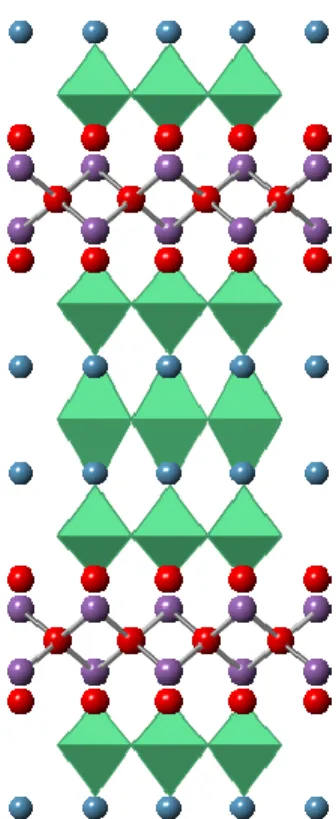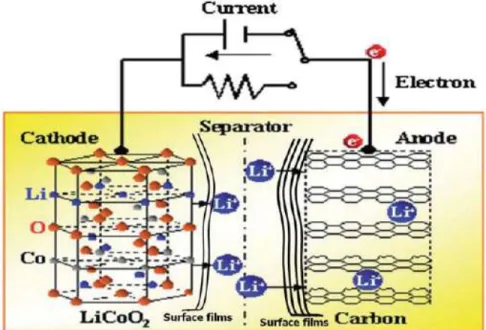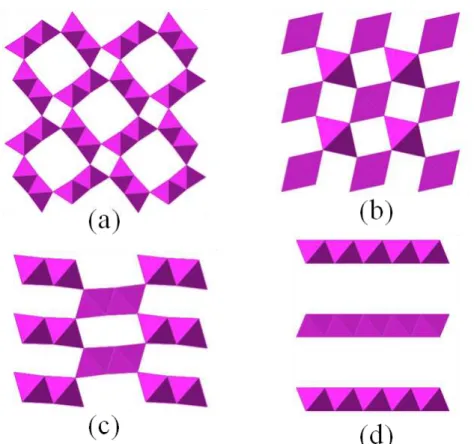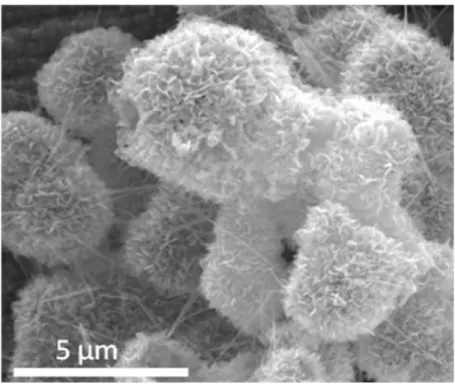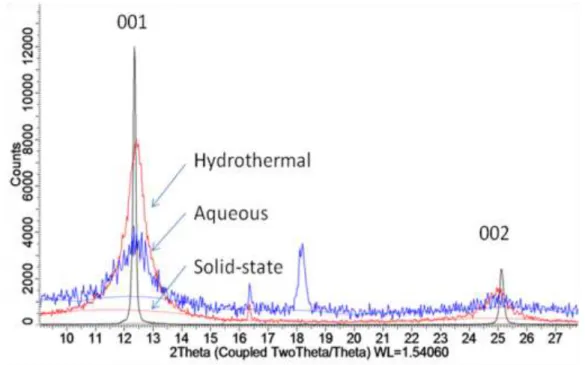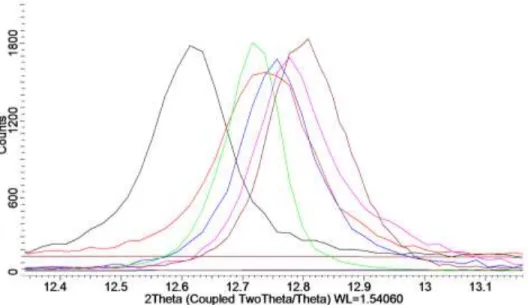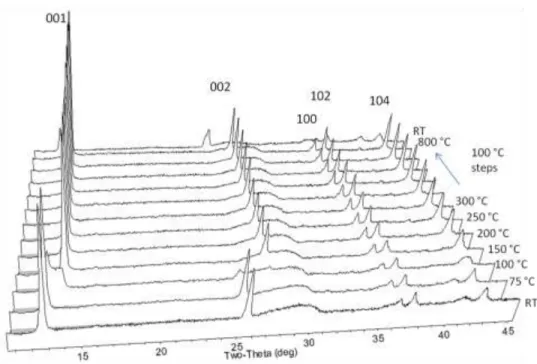My experiences abroad have only served to highlight the quality of the faculty, facilities and students here at Alfred. The list is too long to write properly, but I would like to thank Victoria Blair, Peter Metz, Fiona Cormack, Kyle McDevitt, Peter Sowinski and Tyler Gubb for taking the time to help me get Alfred in and out of prison to come. laboratory. The entire Norris family deserves my endless thanks for accepting me into their home and treating me as a member of the family.
While the thin nanoplates disappear with heat treatment, a large surface area of the initial porous solid is preserved.
Background on Layered Materials
The combination of these different compounds can create sheets with unusual and interesting structures that can be used in various applications. For example, Figure 1 shows KTiNbO5, a stepped titaniobate consisting of 2 octahedra, with adjacent sheets shifted to allow for closer stacking.4 Work has been done on the exfoliation and flocculation of these sheets to determine whether the slight difference in chemistry or sheet morphology leads to any changes in photocatalytic or electrochemical performance.5 Sheets with shorter steps can for example have a higher density of active sites for catalytic reactions if the step edge behaves differently than the middle of the step. Much work has also been done on Aurivillius phase oxides with the composition Bi2An−1BnO3n+3 (BCNN) where the sheet thickness can be adjusted from n=2 to 5 and possibly further, where n is the number of face-to-face octahedra. of the sheet.
Other properties, such as ferroelectricity from distorted octahedra, may arise from the structural relaxation of these sheets of different thickness.
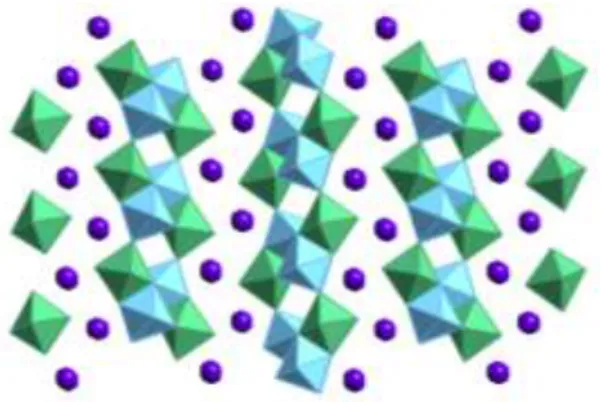
Applications for Energy Storage
Cyclicity is a concern for many rechargeable energy storage solutions, as most often the charge storage mechanism requires the intercalation of ions – usually small alkali ions such as Li + and Na + – in a crystal lattice. A lattice can only accommodate so many intercalated ions in its structure before strain in the lattice causes defects to form in the crystal. The growing area of nanoscience has opened up many new avenues to approach conventional problems in electronics, and more specifically, charge storage.
The concern over rechargeable batteries suggests that there is opportunity for a new type of charge storage - one made from readily available (Earth-abundant) materials that can charge quickly, and have high charge storage capacities.
MnO 2 as an Earth-abundant, Non-toxic, and Easily Processed Material
Cations can also irreversibly intercalate and become trapped in the network, meaning that they are no longer available to participate in the charge transfer process. Manganese oxides perfectly suit this purpose because of the high concentration of Mn compounds in the earth's crust, the variable valence states of Mn with accompanying chemical opportunities, and the willingness of Mn to form multilayer compounds. Another concern with current products is that they rely on heavy metal elements such as bismuth, lead and antimony.
This contrasts with some current materials, such as carbon nanotubes or monocrystalline silicon, which are time-consuming and difficult to produce in large quantities.
Polymorphs of MnO 2
If new advanced materials can be discovered that have similar performance to the expensive rare-earth or precious metal options, the price of current battery materials will quickly cause them to be replaced by the more economical transition metal oxide option. Layered and tunneling polymorphs form from uncomplicated processes that can be scaled up to result in high yields without compromising phase purity. Tunnel-structured materials are of interest for many applications due to their one-dimensional diffusion paths.
The δ-MnO2 polymorph is a naturally layered material in which the edge-sharing sheets of octahedra form planes separated by an interlayer cation.
Behavior of δ-MnO 2
The nature of the interlayer cation is variable, and studies have been conducted to investigate the effect of the interlayer cation on bulk material properties. The potassium ions in the interlayer of highly crystalline δ-MnO2 synthesized via solid-state methods are still mobile species. It has been shown that the introduction of different cations into the interlayer of hydrously prepared birnessites changes the hydration energy of water in the interlayer, and can change the band gap and electrical properties of the material.33,34 Much work has been done on these systems with using hydrothermal or aqueous-precipitated birnessite,29 but there is only limited work on samples exchanged from solid precursors.35 The current work focuses on the ion exchange of solid-synthesized birnessite through conditions similar to those reported for hydrothermal and aqueous, to use. samples in literature.
The addition of tetrabutylammonium hydroxide (TBA-OH) causes swelling and delamination of the Mn-based nanosheets.

Applications of MnO 2
Photocatalytic Activity
Electrochemistry
Sorbents and Filters
Phase Evolution in MnO 2
The microstructures of these flocs were also tracked throughout the processing steps to determine whether these porous solids are stable.
Powder Synthesis
Ion Exchange
Exfoliation
Flocculation
X-ray Diffraction
Scanning Electron Microscopy
Thermogravimetric Analysis
Surface Area Measurement
Electrochemical Measurement
Drop casting was carried out by drying aqueous suspensions of nanosheets or flakes on a cleaned FTO surface at 60 °C. Spray casting was carried out by heating the FTO substrate on a hot plate at 100 °C and using pressurized air to form suspensions of nanosheets. or flakes by spraying a capillary onto the surface. Tape casting was carried out by intimately mixing dried MnO2 nanoleaf flakes with a binder formed from carbon black and polyvinylidene fluoride (PVDF) in a mass ratio of 80:5:15.
The powders were mixed for 6 hours, tape was applied to the FTO surface and dried in a vacuum oven at 120 °C for 4 hours.
Synthesis
XRD performed on zero-background holders indicates that the nanoflowers are stack-disordered δ-MnO2 due to the broadening of the (001) and (002) peaks. By mixing Mn2+ salts such as manganese acetate with hydroxides in water, it was possible to precipitate birnessites with different interlayer cations of the form AxMnO2. Increasing the K:Mn ratio in the compound KxMnO2 leads to slight shifts of the basal (00l) diffraction peaks over the range x=0.35 to x=1.
This is probably due to a difference in hydration of the interlayer, which stabilizes the expansion. In the high-temperature
It is also possible to substitute cations on the manganese sites, instead of the interlayer. Interlayer potassium ion exchange is possible due to the mobility of ions in the layer between the oxide layers. It was found that after two acid ion exchange steps, over 90% of the interlayer potassium was removed and replaced by protons.
The size of the sheet was estimated from the size of the features observed in the SEM images, and an example is shown in Figure 17 . The in-plane diffraction peaks are generally not observed due to the nanosheet orientation on the sample holder. The XRD patterns of the dried nanosheets indicate small amounts of restacking between sheets in the flocculated samples, as evidenced by the broad basal peaks present in the diffraction patterns.
The size of the sheet affects the packing, with larger sheets having more steric hindrance resulting in a more porous and open network.
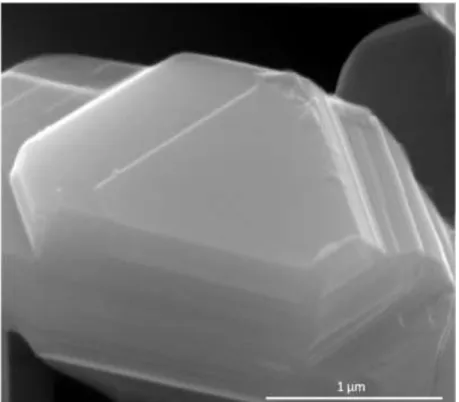
Defects in MnO 2 Nanosheets
When P25 was added to a suspension of nanosheets (0.5 grams in 50 mL), it dispersed without settling out of the suspension. After the addition of HCl to flocculate the nanosheets, the entire suspension flocculated together, both P25 and MnO2.
Electrochemical Performance and the Role of Defects
High-Temperature Phase Stability and Phase Transitions to Form Tunnel-structured α-
Parent phase
As previously mentioned, the synthesized phase is stable at least at 800 °C as observed by HTXRD, with reversible dehydration of the interlayer occurring between 150 and 200 °C (Figure 23). When the birnessite parent phase is subjected to any amount of wet chemical treatment, it loses its high-temperature stability. Even washing the parent phase material in water results in growth of the secondary phase upon subsequent heating to 800 °C.
While the initial diffraction pattern is similar to the unchanged parent phase, above 600 °C a second phase is formed, which persists even after the sample is cooled to room temperature. Phase destabilization is probably due to aqueous dissolution of some intermediate K+ ions. Since the addition of birnessite to water results in an increase in pH, it seems likely that this is due to the scavenging of H+ by the birnessite interlayer, which changes the order of the interlayer by displacing K+ ions and binding to the plate surfaces.
Ion-exchanged phase
The presence of cations larger than Li+ (Na+, Ca+, etc.) appears to stabilize a small amount of α-MnO2, which has a 1-dimensional tunnel structure. In addition to these alkali-containing phases, the formation of Mn2O3 and Mn3O4 is observed where the main phase appears to be controlled by the nature or size of the cation present. Polyvalent elements such as Mg, Sr and Zn favor the growth of Mn3O4 and appear to replace themselves in that lattice, as shown in Table III.
Flocculated material
Through modeling on flocculated MnO2 created as part of this work, Peter Metz from Alfred University was able to fit the cryptomelan structure (α-MnO2) to the measured PDF data (Figure 26). In particular, sodium stimulated the growth of α-MnO2 in addition to Mn2O3, and this is visible in both the formation of Mn2O3, but Mn2O3 crystallized in larger amounts up to 800 °C.
Using EDS we can show that Na is only present in the tubes shown in Figure 28 and not in the Mn2O3 regions. In conjunction with the results of H-flocculated MnO2 showing no α-phase growth at high temperatures (Figure 25), it is likely that the presence of Na+ stabilizes α-MnO2 and promotes its growth during heating.
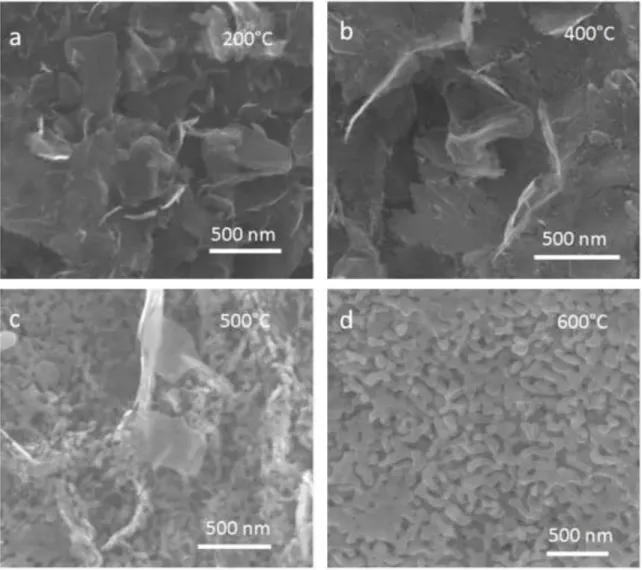
Mechanism of Phase Transformations
Because of the natural distribution of birnessite in Earth's oceans and soil, much work has been done on natural and synthetic manganese compounds. This work and others have shown that the δ polymorph of MnO2 can be used as an intermediate phase for many manganese oxide polymorphs. Sasaki, "Unusual crystallization behaviors of anatase nanocrystallites from a molecularly thin titania nanosheet and its stacked forms: Core temperature enhancement and oriented growth," J.
Sasaki, “High thermal resistance of molecularly thin perovskite nanosheets and implications for superior dielectric properties,” ACS Nano. Sasaki, "Assembly of Graphene Oxide (GO) Superlattice and Titania Nanosheets: Fabrication, In Situ Photocatalytic Reduction of GO, and Highly Enhanced Carrier Transport". Oh, “Preparation of layered MnO2 via thermal decomposition of KMnO4 and its electrochemical characteristics,” Chem.
Ooi, “Single-Crystal Growth of Birnessite- and Hollandite-Type Manganese Oxides by the Flow Method,” Cryst. Ooi, “Hydrothermal synthesis of lithium and sodium manganese oxides and their metal ion extraction/insertion reactions,” Chem. Tomida, "Swelling and Delamination Behavior of Birnessite-Type Manganese Oxide by Intercalation of Tetraalkylammonium Ions," Langmuir.
Li, “Surface and structural investigation of a Birnessite MnOx-type water oxidation catalyst formed under photocatalytic conditions,” Chem. Suib, “Catalysis of water oxidation using amorphous manganese oxides, octahedral molecular sieves (OMS-2) and octahedral layered manganese oxide structures (OL-1),” J.
